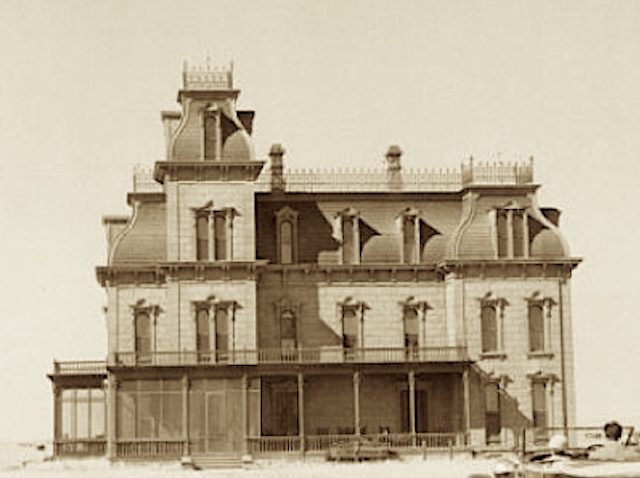I refer to the James Dean movie, Giant, which premiered in 1956. It was his third and final film, as he died in a car accident before the film was released. Also featuring Elizabeth Taylor and Rock Hudson, Giant was a giant critical and popular success. 88% fresh at Rotten T.
The reason it is of interest here is that Bell Cay, proprietor of The Original Haunted Mansion Fan Club (on FB), believes the house in Giant, also known as the Marfa-Ryan ranch house, served as the inspiration for the Mansion façade as proposed in early artwork by Ken Anderson, Sam McKim, and Marvin Davis. It's well-known and I've posted it more than once. The repetition doesn't bother me, since it's too gorgeous.
I'm pretty sure we have Sam McKim to thank for the sketch below.
The Marfa-Ryan house (which was only a movie façade, never a real building) is the central location in Giant, visually and psychologically. It could have been seen by Anderson in 1956, not long before he first sketched the above house design in 1957. Given the popularity of the movie, the prominence of the ranch house in it, and the time proximity, the possibility of influence cannot be denied, and at first glance, there does seem to be some resemblance.
Especially if you flip it:
Also, in the movie, the house is eerily isolated in a vast space, which gives it a kind of an Edward Hopper creepiness.
(Hold that thought, because Hopper makes another appearance below.)
The biggest problems for me are that (1) the more you look at the two buildings, the less similar they look. At least for me, the resemblance that strikes you at first glance tends to fade under closer examination. Also, (2) the architectural features in both buildings are so common that it isn't hard to scare up other artwork equally reminiscent of the Anderson house:What about the Psycho house? Nah, not even worth a side-by-side. The problem is that PM is a pretty generic example of Victorian architecture from the second half of the 19th century ("Second Empire" Victorian), and you can find plenty of real houses that can't help but remind you of PM. My favorite is the Joseph R. Bodwell house in Hollowell, Minnesota (1875), but if you scratch around enough you'll find other candidates.
Knock yourself out. That's a phantom I'm not particularly interested in chasing.













Great references. I found searching "second empire house old west" will snag you plenty of lookalikes, but none quite as compelling as these.
ReplyDeleteCan't wait for you to weigh in on the new Disneyland attic! From what I've seen, I like the new bride and hope WDW will follow suit. I like the idea of going back to the hints of a more tragic backstory. But the first thing I thought when I saw the videos of her was, "this looks like that bit of pre-Constance concept art on the Long Forgotten blog...the one that the writer called 'a coked-up version of the middle bride.'"
ReplyDeleteI'm also going to go out on a limb and say that you'll be more in favor of the new Disneyland queue than the WDW one you call "Pepe Le Queue." It seems to me that the new DL queue has some interesting allusions to the inhabitants of the Mansion without going over-the-top.
I was thinking the same thing about the "coked-up Connie" artwork. I'll be writing a full review of the changes to the DL HM, so hold on.
DeleteOne need not go so far afield to find a fantom manor. This one is located in Bound Brook NJ. https://www.facebook.com/share/19gqjYEVGC/
ReplyDelete